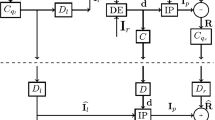Abstract
Our paper introduces a novel approach for controlling stereo camera parameters in interactive 3D environments in a way that specifically addresses the interplay of binocular depth perception and saliency of scene contents. Our proposed Dynamic Attention-Aware Disparity Control (DADC) method produces depth-rich stereo rendering that improves viewer comfort through joint optimization of stereo parameters. While constructing the optimization model, we consider the importance of scene elements, as well as their distance to the camera and the locus of attention on the display. Our method also optimizes the depth effect of a given scene by considering the individual user’s stereoscopic disparity range and comfortable viewing experience by controlling accommodation/convergence conflict. We validate our method in a formal user study that also reveals the advantages, such as superior quality and practical relevance, of considering our method.









Similar content being viewed by others
References
Recommendation itu-r bt. 2021: Subjective methods for the assessment of stereoscopic 3dtv systems (2012)
Didyk, P., Ritschel, T., Eisemann, E., Myszkowski, K., Seidel, H.P.: A perceptual model for disparity. ACM Trans. Graph. 30(4) (2011). doi:10.1145/2010324.1964991 (Proceedings SIGGRAPH 2011, Vancouver)
Didyk, P., Ritschel, T., Eisemann, E., Myszkowski, K., Seidel, H.P., Matusik, W.: A luminance-contrast-aware disparity model and applications. ACM Trans. Graph. 31(6), 184:1–184:10 (2012)
Greß, A., Guthe, M., Klein, R.: Gpu-based collision detection for deformable parameterized surfaces. Comput. Graph. Forum 25, 497–506 (2006)
Guttmann, M., Wolf, L., Cohen-Or, D.: Semi-automatic stereo extraction from video footage. In: IEEE 12th International Conference on Computer Vision, pp. 136–142. IEEE Press, New York (2009)
Heinzle, S., Greisen, P., Gallup, D., Chen, C., Saner, D., Smolic, A., Burg, A., Matusik, W., Gross, M.: Computational stereo camera system with programmable control loop. ACM Trans. Graph. 30, 94:1–94:10 (2011)
Howard, I.P., Rogers, B.J.: Seeing in Depth. Depth Perception, vol. 2. I Porteous, Toronto (2002)
Itti, L., Koch, C.: Computational modelling of visual attention. Nat. Rev. Neurosci. 2(3), 194–203 (2001)
Johnson, S.: The nlopt nonlinear-optimization package (2011). http://ab-initio.mit.edu/nlopt
Jones, G.R., Lee, D., Holliman, N.S., Ezra, D.: Controlling Perceived Depth in Stereoscopic Images. SPIE Press, Bellingham (2001)
Koppal, S., Zitnick, C., Cohen, M., Kang, S.B., Ressler, B., Colburn, A.: A viewer-centric editor for 3d movies. IEEE Comput. Graph. Appl. 31(1), 20–35 (2011)
Lang, M., Hornung, A., Wang, O., Poulakos, S., Smolic, A., Gross, M.: Nonlinear disparity mapping for stereoscopic 3d. ACM Trans. Graph. 29(4), 75:1–75:10 (2010)
Liu, C.W., Huang, T.H., Chang, M.H., Lee, K.Y., Liang, C.K., Chuang, Y.Y.: 3d cinematography principles and their applications to stereoscopic media processing. In: Proceedings of the 19th ACM International Conference on Multimedia, MM ’11, pp. 253–262. ACM Press, New York (2011)
Mendiburu, B.: 3D Movie Making: Stereoscopic Digital Cinema from Script to Screen. Focal Press, Waltham (2009)
Milgram, P., Krüger, M.: Adaptation effects in stereo due to on-line changes in camera configuration. In: Proc. SPIE, Stereoscopic Displays and Applications III, vol. 1669-13 (1992). SPIE Press, Bellingham
Oskam, T., Hornung, A., Bowles, H., Mitchell, K., Gross, M.: Oscam-optimized stereoscopic camera control for interactive 3d. In: SA’11 Proceedings of the 2011 SIGGRAPH Asia Conference, vol. 30, p. 189. ACM Press, New York (2011)
Reddy, M.: Perceptually optimized 3d graphics. IEEE Comput. Graph. Appl. 21(5), 68–75 (2001)
Runarsson, T.P., Yao, X.: Stochastic ranking for constrained evolutionary optimization. IEEE Trans. Evol. Comput. 4(3), 284–294 (2000)
Shamir, A., Sorkine, O.: Visual media retargeting. In: ACM SIGGRAPH ASIA 2009 Courses, SIGGRAPH ASIA ’09, pp. 11:1–11:13. ACM Press, New York (2009)
Zilly, F., Kluger, J., Kauff, P.: Production rules for stereo acquisition. Proc. IEEE 99(4), 590–606 (2011)
Zilly, F., Muller, M., Kauff, P., Schafer, R.: Stan—an assistance system for 3d productions: from bad stereo to good stereo. In: 2011 14th ITG Conference on Electronic Media Technology (CEMT), pp. 1–6. IEEE Press, New York (2011)
Acknowledgements
We would like to thank Dr. Ugur Gudukbay, Aytek Aman and Ates Akaydin for supplying some of the 3D human models used in our scenes; Sami Arpa and the 3dios Productions for providing the 3D display equipment; and also the anonymous reviewers for their valuable suggestions. This work is supported by the Scientific and Technical Research Council of Turkey (TUBITAK, project number 110E029).
Author information
Authors and Affiliations
Corresponding author
Rights and permissions
About this article
Cite this article
Celikcan, U., Cimen, G., Kevinc, E.B. et al. Attention-Aware Disparity Control in interactive environments. Vis Comput 29, 685–694 (2013). https://doi.org/10.1007/s00371-013-0804-6
Published:
Issue Date:
DOI: https://doi.org/10.1007/s00371-013-0804-6




